PEUGEOT 4007 2007 Owners Manual
Manufacturer: PEUGEOT, Model Year: 2007, Model line: 4007, Model: PEUGEOT 4007 2007Pages: 221, PDF Size: 13.99 MB
Page 131 of 221

8
i
CHECKSCHECKS
Diesel additive level (Diesel
with particle emission filter)
The minimum level of this additive is indicated by lighting
of the service warning light, accompanied by an aud ible
signal and a message on the multifunction display.
Topping up
It is imperative that this additive is
topped up by a PEUGEOT dealer with-
out delay.
Used products
CHECKS
Unless otherwise indicated, check
these components in accordance with
the servicing booklet and in relation to
your engine.
Otherwise, have them checked by a
PEUGEOT dealer.
Battery
Check the electrolyte level
regularly. If necessary, top up
the level with distilled water.
Check that the terminals are
clean and correctly tightened,
particularly in summer and winter.
When carrying out work on the battery,
refer to the "Practical information" sec-
tion for details of the precautions to be
taken before disconnecting the battery
and following its reconnection.
Air filter and passenger compartment filter
Refer to the servicing booklet
for details of the replacement
intervals for these compo-
nents.
Depending on the environ-
ment (dusty atmosphere...) and the use
of the vehicle (city driving...), replace
them twice as often if necessary (refer
to the "Engines" paragraph).
� �A� �c�l�o�g�g�e�d� �p�a�s�s�e�n�g�e�r� �c�o�m�p�a�r�t�m�e�n�t� �fi� �l�-
ter may have an adverse effect on the
performance of the air conditioning sys-
tem and generate undesirable odours. Oil filter
� �R�e�p�l�a�c�e� �t�h�e� �o�i�l� �fi� �l�t�e�r� �e�a�c�h� �t�i�m�e�
the engine oil is changed.
Refer to the servicing booklet
for details of the replacement
interval for this component.
Particle emission filter (Diesel)
It is imperative that the maintenance of
�t�h�e� �p�a�r�t�i�c�l�e� �e�m�i�s�s�i�o�n� �fi� �l�t�e�r� �i�s� �c�a�r�r�i�e�d� �o�u�t�
by a PEUGEOT dealer.
Following prolonged operation
of the vehicle at very low speed
or at idle, you may, exception-
ally, notice the emission of water
vapour at the exhaust on accel-
eration. This does not have any
adverse effect on the perform-
ance of the vehicle or on the en-
vironment.
Avoid any prolonged contact of
�u�s�e�d� �o�i�l� �o�r� �fl� �u�i�d�s� �w�i�t�h� �t�h�e� �s�k�i�n�.�
� �M�o�s�t� �o�f� �t�h�e�s�e� �fl� �u�i�d�s� �a�r�e� �h�a�r�m�f�u�l�
to health or indeed very corro-
sive.
� �D�o� �n�o�t� �d�i�s�c�a�r�d� �u�s�e�d� �o�i�l� �o�r� �fl� �u�i�d�s�
into sewers or onto the ground.
Empty used oil into the contain-
ers provided for this purpose in
the PEUGEOT network. � �D�o� �n�o�t� �d�i�s�c�a�r�d� �t�h�e� �o�i�l� �fi� �l�t�e�r�
through public channels, depos-
it it in the containers dedicated
to this use in the PEUGEOT net-
work.
Page 132 of 221
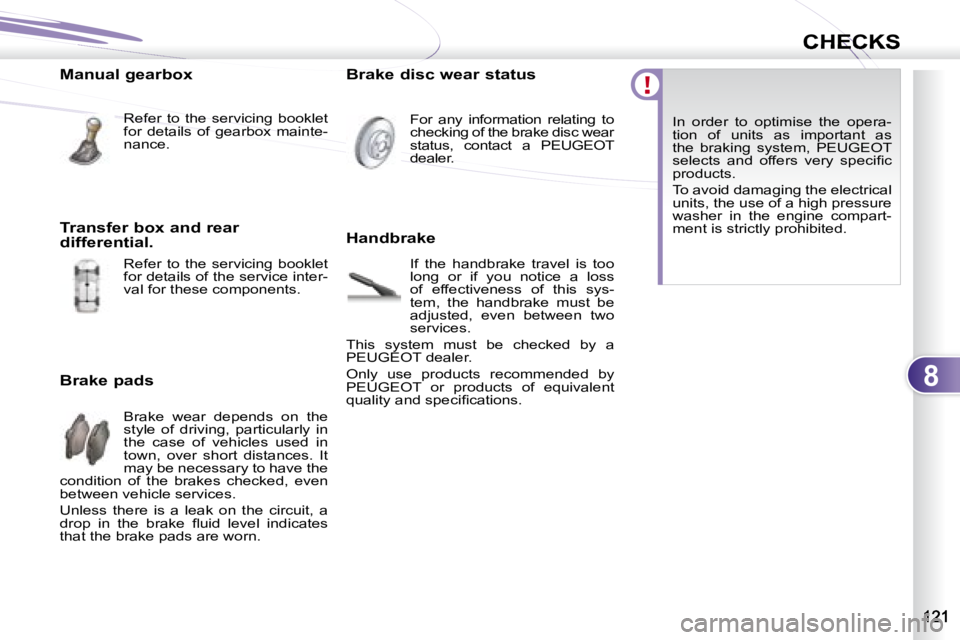
8
CHECKSCHECKS
Manual gearbox Refer to the servicing booklet
for details of gearbox mainte-
nance.
Brake pads Brake wear depends on the
style of driving, particularly in
the case of vehicles used in
town, over short distances. It
may be necessary to have the
condition of the brakes checked, even
between vehicle services.
Unless there is a leak on the circuit, a
�d�r�o�p� �i�n� �t�h�e� �b�r�a�k�e� �fl� �u�i�d� �l�e�v�e�l� �i�n�d�i�c�a�t�e�s�
that the brake pads are worn. Brake disc wear status
For any information relating to
checking of the brake disc wear
status, contact a PEUGEOT
dealer.
Handbrake If the handbrake travel is too
long or if you notice a loss
of effectiveness of this sys-
tem, the handbrake must be
adjusted, even between two
services.
This system must be checked by a
PEUGEOT dealer.
Only use products recommended by
PEUGEOT or products of equivalent
�q�u�a�l�i�t�y� �a�n�d� �s�p�e�c�i�fi� �c�a�t�i�o�n�s�.� In order to optimise the opera-
tion of units as important as
the braking system, PEUGEOT
�s�e�l�e�c�t�s� �a�n�d� �o�f�f�e�r�s� �v�e�r�y� �s�p�e�c�i�fi� �c�
products.
To avoid damaging the electrical
units, the use of a high pressure
washer in the engine compart-
ment is strictly prohibited.
Transfer box and rear
differential.
Refer to the servicing booklet
for details of the service inter-
val for these components.
Page 133 of 221
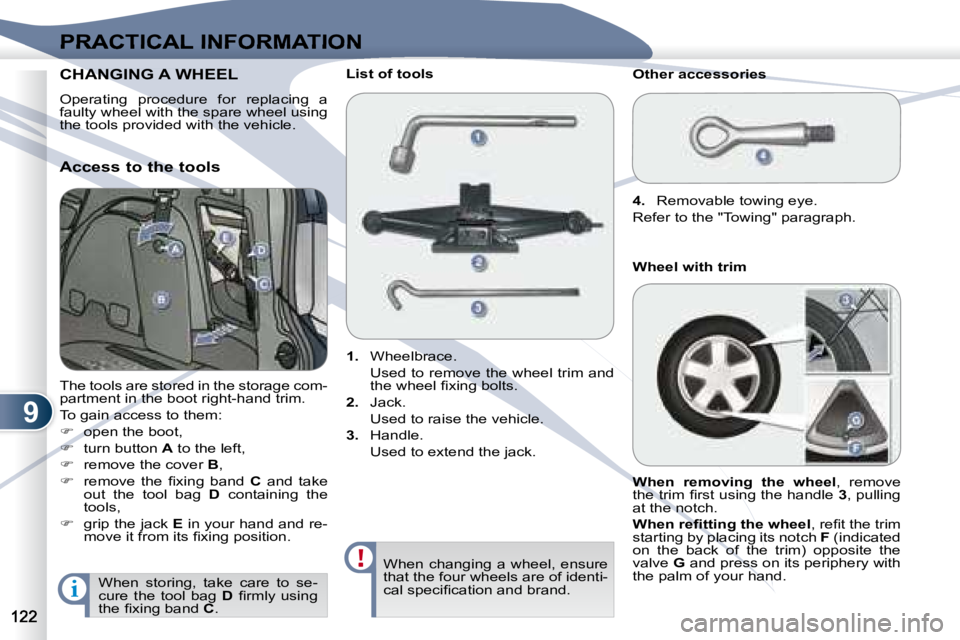
9
i
PRACTICAL INFORMATION
CHANGING CHANGING A WHEEL
Operating procedure for replacing a
faulty wheel with the spare wheel using
the tools provided with the vehicle.
The tools are stored in the storage com-
partment in the boot right-hand trim.
To gain access to them:
� open the boot,
� turn button A to the left,
� remove the cover B ,
� � � �r�e�m�o�v�e� �t�h�e� �fi� �x�i�n�g� �b�a�n�d� � C and take
out the tool bag D containing the
tools,
� grip the jack E in your hand and re-
�m�o�v�e� �i�t� �f�r�o�m� �i�t�s� �fi� �x�i�n�g� �p�o�s�i�t�i�o�n�.� �
1. Wheelbrace.
Used to remove the wheel trim and �t�h�e� �w�h�e�e�l� �fi� �x�i�n�g� �b�o�l�t�s�.�
2. Jack.
Used to raise the vehicle.
3. Handle.
� �U�s�e�d� �t�o� �e�x�t�e�n�d� �t�h�e� �j�a�c�k�.�
List of tools
Other accessories
4. Removable towing eye.
Refer to the "Towing" paragraph.
Access to the tools
Wheel with trim
When changing a wheel, ensure
that the four wheels are of identi-
�c�a�l� �s�p�e�c�i�fi� �c�a�t�i�o�n� �a�n�d� �b�r�a�n�d�.� � �
When removing the wheel , remove
�t�h�e� �t�r�i�m� �fi� �r�s�t� �u�s�i�n�g� �t�h�e� �h�a�n�d�l�e� � 3 , pulling
at the notch.
�W�h�e�n� �r�e�fi� �t�t�i�n�g� �t�h�e� �w�h�e�e�l � �,� �r�e�fi� �t� �t�h�e� �t�r�i�m�
starting by placing its notch F (indicated
on the back of the trim) opposite the
valve G and press on its periphery with
the palm of your hand.
When storing, take care to se-
cure the tool bag D � �fi� �r�m�l�y� �u�s�i�n�g�
�t�h�e� �fi� �x�i�n�g� �b�a�n�d� � C .
Page 134 of 221
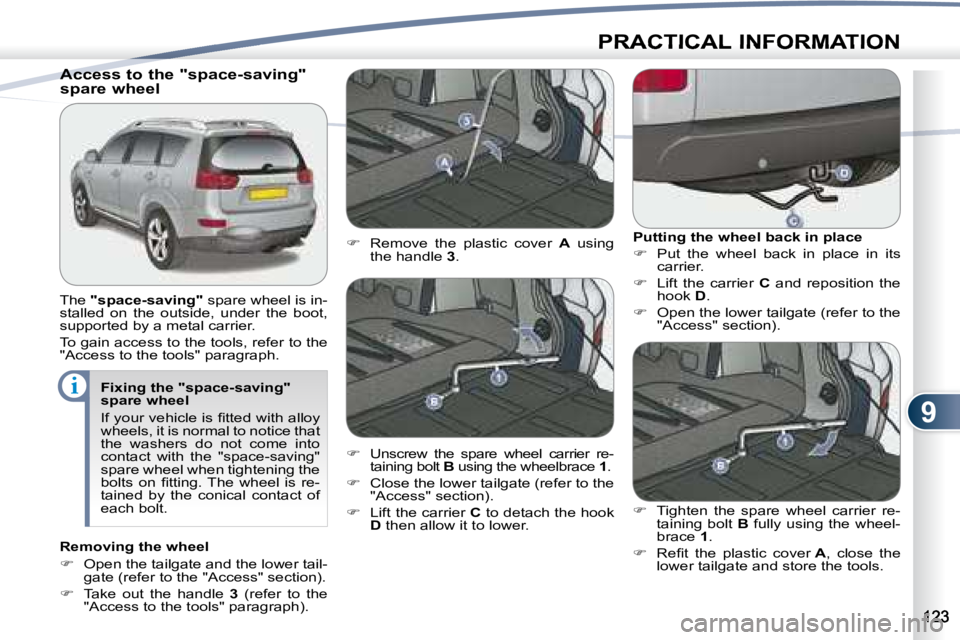
9
i
PRACTICAL INFORMATION
Fixing the "space-saving"
spare wheel
� �I�f� �y�o�u�r� �v�e�h�i�c�l�e� �i�s� �fi� �t�t�e�d� �w�i�t�h� �a�l�l�o�y�
wheels, it is normal to notice that
the washers do not come into
contact with the "space-saving"
spare wheel when tightening the
�b�o�l�t�s� �o�n� �fi� �t�t�i�n�g�.� �T�h�e� �w�h�e�e�l� �i�s� �r�e�-
tained by the conical contact of
each bolt.
Access to the "space-saving"
spare wheel
The "space-saving" spare wheel is in-
stalled on the outside, under the boot,
supported by a metal carrier.
To gain access to the tools, refer to the
"Access to the tools" paragraph. Putting the wheel back in place
� Put the wheel back in place in its
carrier.
� Lift the carrier C and reposition the
hook D .
� Open the lower tailgate (refer to the
"Access" section).
� Remove the plastic cover A using
the handle 3 .
� Unscrew the spare wheel carrier re-
taining bolt B using the wheelbrace 1 .
� Close the lower tailgate (refer to the
"Access" section).
� Lift the carrier C to detach the hook
D then allow it to lower.
� Tighten the spare wheel carrier re-
taining bolt B fully using the wheel-
brace 1 .
� � � �R�e�fi� �t� �t�h�e� �p�l�a�s�t�i�c� �c�o�v�e�r� � A , close the
lower tailgate and store the tools.
Removing the wheel
� Open the tailgate and the lower tail-
gate (refer to the "Access" section).
� Take out the handle 3 (refer to the
"Access to the tools" paragraph).
Page 135 of 221
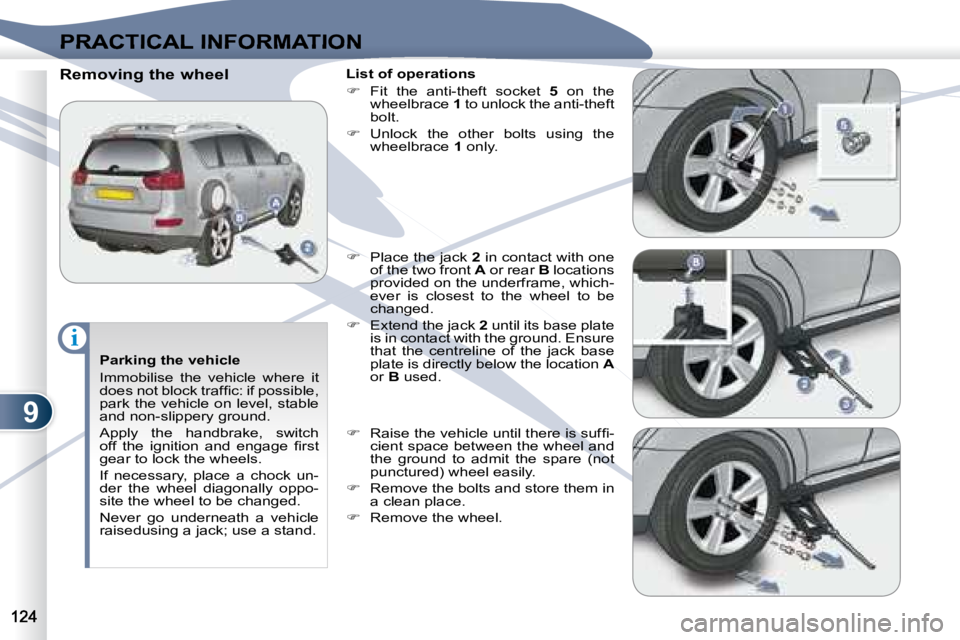
9
i
PRACTICAL INFORMATION
Parking the vehicle
Immobilise the vehicle where it
�d�o�e�s� �n�o�t� �b�l�o�c�k� �t�r�a�f�fi� �c�:� �i�f� �p�o�s�s�i�b�l�e�,�
park the vehicle on level, stable
and non-slippery ground.
Apply the handbrake, switch
�o�f�f� �t�h�e� �i�g�n�i�t�i�o�n� �a�n�d� �e�n�g�a�g�e� �fi� �r�s�t�
gear to lock the wheels.
If necessary, place a chock un-
der the wheel diagonally oppo-
site the wheel to be changed.
Never go underneath a vehicle
raisedusing a jack; use a stand.
Removing the wheel
List of operations
� Fit the anti-theft socket 5 on the
wheelbrace 1 to unlock the anti-theft
bolt.
� Unlock the other bolts using the
wheelbrace 1 only.
� Place the jack 2 in contact with one
of the two front A or rear B locations
provided on the underframe, which-
ever is closest to the wheel to be
changed.
� � � �E�x�t�e�n�d� �t�h�e� �j�a�c�k� � 2 until its base plate
is in contact with the ground. Ensure
that the centreline of the jack base
plate is directly below the location A
or B used.
� � � �R�a�i�s�e� �t�h�e� �v�e�h�i�c�l�e� �u�n�t�i�l� �t�h�e�r�e� �i�s� �s�u�f�fi� �-
cient space between the wheel and
the ground to admit the spare (not
punctured) wheel easily.
� Remove the bolts and store them in
a clean place.
� Remove the wheel.
Page 136 of 221
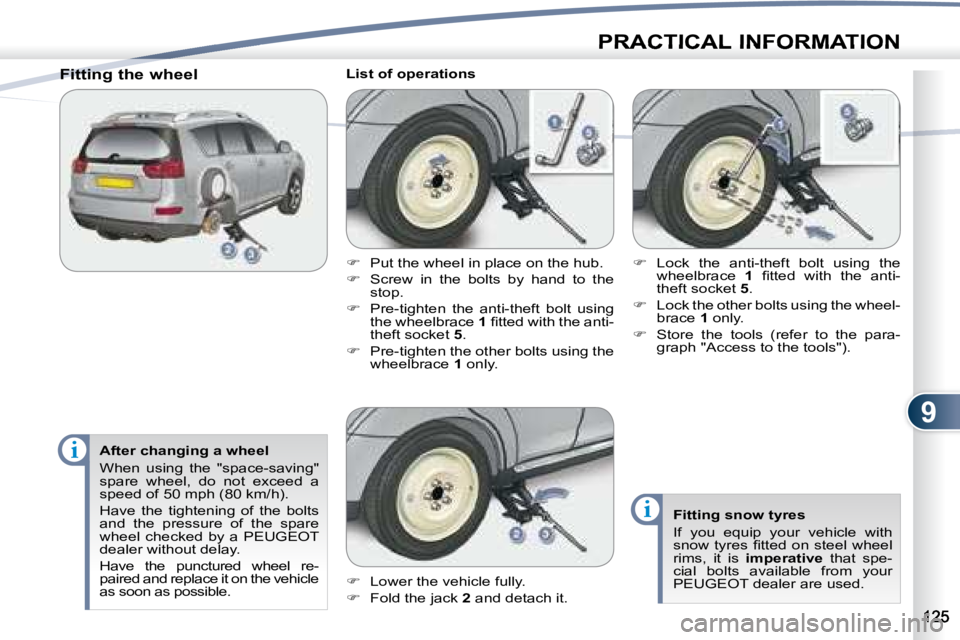
9
i
i
PRACTICAL INFORMATION
After changing a wheel
When using the "space-saving"
�s�p�a�r�e� �w�h�e�e�l�,� �d�o� �n�o�t� �e�x�c�e�e�d� �a�
speed of 50 mph (80 km/h).
Have the tightening of the bolts
and the pressure of the spare
wheel checked by a PEUGEOT
dealer without delay.
Have the punctured wheel re-
paired and replace it on the vehicle
as soon as possible.
Fitting the wheel
List of operations
� Lower the vehicle fully.
� Fold the jack 2 and detach it.
� Lock the anti-theft bolt using the
wheelbrace 1� � �fi� �t�t�e�d� �w�i�t�h� �t�h�e� �a�n�t�i�-
theft socket 5 .
� Lock the other bolts using the wheel-
brace 1 only.
� Store the tools (refer to the para-
graph "Access to the tools").
Fitting snow tyres
If you equip your vehicle with
�s�n�o�w� �t�y�r�e�s� �fi� �t�t�e�d� �o�n� �s�t�e�e�l� �w�h�e�e�l�
rims, it is imperative that spe-
cial bolts available from your
PEUGEOT dealer are used.
� Put the wheel in place on the hub.
� Screw in the bolts by hand to the
stop.
� Pre-tighten the anti-theft bolt using
the wheelbrace 1� � �fi� �t�t�e�d� �w�i�t�h� �t�h�e� �a�n�t�i�-
theft socket 5 .
� Pre-tighten the other bolts using the
wheelbrace 1 only.
Page 137 of 221
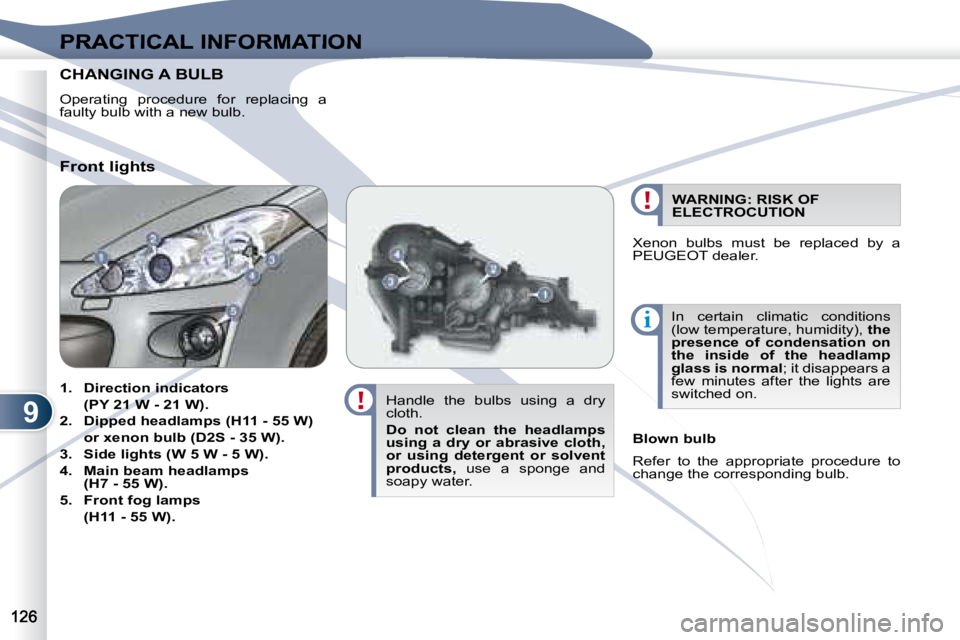
9
i
PRACTICAL INFORMATION
CHANGING CHANGING A BULB
Operating procedure for replacing a
faulty bulb with a new bulb. Handle the bulbs using a dry
cloth.
Do not clean the headlamps
using a dry or abrasive cloth,
or using detergent or solvent
products, use a sponge and
soapy water. In certain climatic conditions
(low temperature, humidity),
t
he
presence of condensation on
the inside of the headlamp
glass is normal ; it disappears a
few minutes after the lights are
switched on.
Front lights
Blown bulb
Refer to the appropriate procedure to
change the corresponding bulb.
1. Direction indicators
(PY 21 W - 21 W).
2. Dipped headlamps (H11 - 55 W)
or xenon bulb (D2S - 35 W).
3. Side lights (W 5 W - 5 W).
4. Main beam headlamps
(H7 - 55 W).
5. Front fog lamps
(H11 - 55 W). WARNING: RISK OF
ELECTROCUTION
Xenon bulbs must be replaced by a
PEUGEOT dealer.
Page 138 of 221
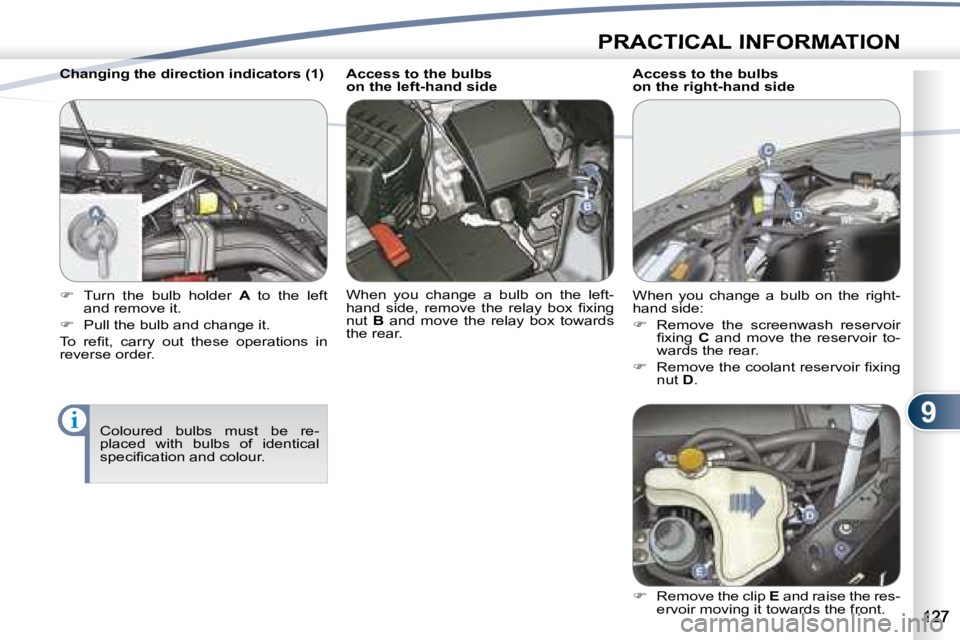
9i
PRACTICAL INFORMATION
Changing the direction indicators (1) Coloured bulbs must be re-
placed with bulbs of identical
�s�p�e�c�i�fi� �c�a�t�i�o�n� �a�n�d� �c�o�l�o�u�r�.� � �
� Turn the bulb holder A to the left
and remove it.
� Pull the bulb and change it.
� �T�o� �r�e�fi� �t�,� �c�a�r�r�y� �o�u�t� �t�h�e�s�e� �o�p�e�r�a�t�i�o�n�s� �i�n�
reverse order. Access to the bulbs
on the left-hand side
When you change a bulb on the left-
�h�a�n�d� �s�i�d�e�,� �r�e�m�o�v�e� �t�h�e� �r�e�l�a�y� �b�o�x� �fi� �x�i�n�g�
nut
B� � �a�n�d� �m�o�v�e� �t�h�e� �r�e�l�a�y� �b�o�x� �t�o�w�a�r�d�s�
the rear. Access to the bulbs
on the right-hand side
When you change a bulb on the right-
hand side:
� Remove the screenwash reservoir
�fi� �x�i�n�g� � C and move the reservoir to-
wards the rear.
� � � �R�e�m�o�v�e� �t�h�e� �c�o�o�l�a�n�t� �r�e�s�e�r�v�o�i�r� �fi� �x�i�n�g�
nut D .
� Remove the clip E and raise the res-
ervoir moving it towards the front.
Page 139 of 221
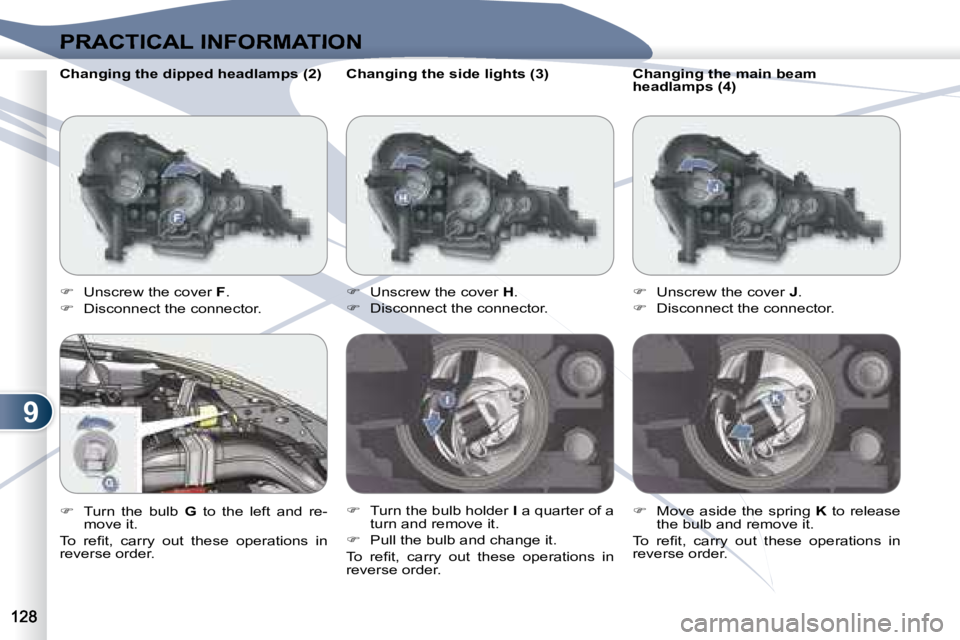
9
PRACTICAL INFORMATION
Changing the side lights (3)
� Unscrew the cover H .
� Disconnect the connector.
� Turn the bulb holder I a quarter of a
turn and remove it.
� Pull the bulb and change it.
� �T�o� �r�e�fi� �t�,� �c�a�r�r�y� �o�u�t� �t�h�e�s�e� �o�p�e�r�a�t�i�o�n�s� �i�n�
reverse order.
� Unscrew the cover F .
� Disconnect the connector.
� Turn the bulb G to the left and re-
move it.
� �T�o� �r�e�fi� �t�,� �c�a�r�r�y� �o�u�t� �t�h�e�s�e� �o�p�e�r�a�t�i�o�n�s� �i�n�
reverse order.
Changing the dipped headlamps (2)
Changing the main beam
headlamps (4)
� Unscrew the cover J .
� Disconnect the connector.
� Move aside the spring K to release
the bulb and remove it.
� �T�o� �r�e�fi� �t�,� �c�a�r�r�y� �o�u�t� �t�h�e�s�e� �o�p�e�r�a�t�i�o�n�s� �i�n�
reverse order.
Page 140 of 221
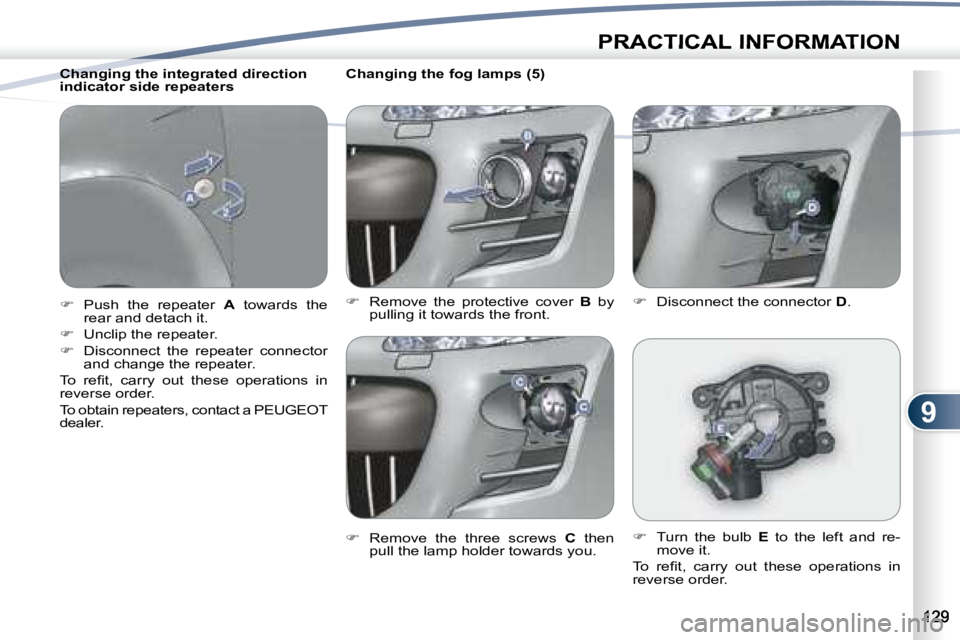
9
PRACTICAL INFORMATION
Changing the fog lamps (5)
� Remove the protective cover B by
pulling it towards the front.
� Remove the three screws C then
pull the lamp holder towards you.
� Turn the bulb E to the left and re-
move it.
� �T�o� �r�e�fi� �t�,� �c�a�r�r�y� �o�u�t� �t�h�e�s�e� �o�p�e�r�a�t�i�o�n�s� �i�n�
reverse order.
� Disconnect the connector D .
Changing the integrated direction
indicator side repeaters
� Push the repeater A towards the
rear and detach it.
� Unclip the repeater.
� Disconnect the repeater connector
and change the repeater.
� �T�o� �r�e�fi� �t�,� �c�a�r�r�y� �o�u�t� �t�h�e�s�e� �o�p�e�r�a�t�i�o�n�s� �i�n�
reverse order.
To obtain repeaters, contact a PEUGEOT
dealer.